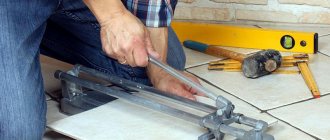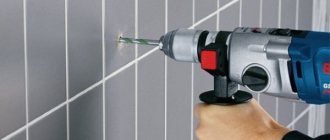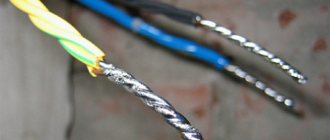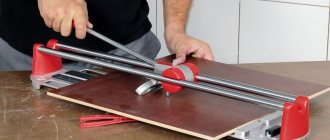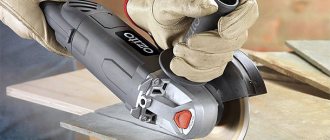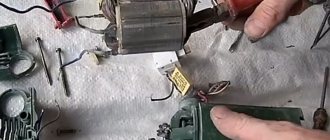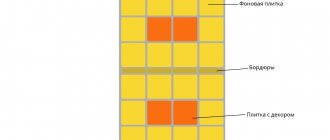Briefly about the types of tiles
Mosaic tiles, tiled or porcelain tiles are used for wall and floor cladding. In the case of the first, as a rule, it is enough to have a construction knife or scissors on hand to cut the mesh of the fabric formed at the factory. Cutting larger samples requires a power tool or a manual tile cutter. Let's look at what you need to know about the facing material before cutting tiles with a grinder.
Ceramic products are characterized by high hardness and strength. These can be samples in a solid or two-layer design (with a decorative coating). The main disadvantage of materials is fragility. A point mechanical load can cause the blade to burst and the edges to chip during cutting. These points are important to consider when choosing a particular tool.
Cut line with small chips Source yandex.net
Electric motor speed
The second important point that determines the quality of cutting hard materials is the speed of rotation of the disk. The higher the speed, the more intense the impact, the easier the edge bites into the ceramic.
You can also get a high-quality cut with a grinder
When passing quickly, the tiles do not have time to heat up, which also reduces the number of chips, so you need a grinder that is powerful, but at the same time compact, so that you can quickly operate it.
Choosing equipment for cutting tiles
To understand how to cut tiles with a grinder without chipping, you need to find out the criteria for choosing a tool. Since the cladding is fragile, it would be correct to carry out the work with a small device with a power of up to 1 kW. The ability to adjust the speed limit will also be relevant here. A reduction in speed may be necessary to eliminate the possibility of chips and cracks. As a rule, work occurs at 3-3.5 thousand rpm.
Regarding replacement equipment, it is recommended to choose a 125 mm circle. The small diameter disc allows you to perform work with greater precision. However, it is worth considering that productivity and working life will be higher with equipment from 150 mm. That is, for a large-scale project it is better to consider cutting wheels of larger sizes. But the decision must be made taking into account the simultaneous increase in the weight of the power tool.
Let's consider which grinder disc to cut ceramic tiles or porcelain stoneware. Craftsmen, as a rule, make a choice in favor of a diamond-coated steel sample.
Diamond segmented blade Source prom.st
See also: Catalog of companies that specialize in the reconstruction and rebuilding of houses
The thickness of the edge is over 2 mm. Thinner circles are installed in machine equipment, and in the case of manual ones, there is a high probability of damage to the equipment or facing fabric. The reason is jerks and impacts.
The following types of diamond blades can be used for cutting material:
- Segmented . The cutting edge here is divided into several sections by small slots. The edges are coated with synthetic diamonds. Such a disk device allows the blade to cool, which extends the working time (approach) to 1.5 minutes. The break should be taken at idle for 20-30 seconds. Application: dry cutting.
- Solid . The circle is made solid, with diamond chips applied to the edge. It is better to use this disc to process the cutting line; the cutting will be neat. The cooling effect requires water - you can wet the tiles.
- Combined . This is a universal disc for cutting ceramic tiles for an angle grinder. Inferior to those segmented in terms of working time, continuous in accuracy.
Combined design of cutting wheel Source ozone.ru
Craftsmen recommend considering cutting wheels taking into account the height of the facing material. The working life will be higher if the thickness of the tile is less than the width of the sprayed edge. This way the diamond chips will do the job longer.
In addition to the above, the density and fraction of the synthetic coating are subject to consideration. Especially if you plan to cut porcelain stoneware or thick tiles, a large amount of work is expected to be performed. In this case, you need to choose wet cutting discs with relatively coarse diamond chips.
Precautionary measures
Any cutting wheel must be replaced if it becomes damaged. It is easy to identify them - sparks appear from the contact of steel with ceramics. This phenomenon can lead either to chips and cracks in the tiles, or to breakage of the disk during operation. The latter is dangerous for the operator. Some craftsmen try to correct the situation by grinding off the defect and continue working. But such equipment is already considered faulty.
Example of damaged equipment Source sdska.ru
Before cutting tiles with a grinder without chipping using a diamond blade, you need to protect yourself from a large amount of dust during dry cutting. Here you will need not only gloves and a respirator. It is also necessary to use glasses and a protective tool cover. Some craftsmen remove the latter for better visibility, which increases the risk of injury from unexpected sparks. Here the solution is a contrast marker or applying clear scratched markings (you can use a glass cutter).
How to choose the right disk?
Depending on the modification of the disc, the grinder is capable of processing a wide variety of materials - metals, wood, porcelain stoneware, reinforced concrete, natural stone, etc.
What determines the price of a circle?
Replaceable elements intended for processing hard materials, as a rule, have diamond coating, which gives the cutting edge special strength. It is the diamond coating that significantly increases the cost of attachment wheels. But they are also the strongest and most durable, easily coping with complex processing tasks.
A more simplified version is a stone disc designed for sawing a small amount of tile. It costs much less, but wears out faster, creates a lot of dust and does not allow achieving high precision processing.
The final cost of the product is influenced by the pricing policy of the manufacturer.
Products from such famous world brands as Hitachi, Bosch, Distar will cost much more than products from less well-known brands. Professional cutting wheels with diameters from 125 mm to 350 mm are also very expensive. They are characterized by maximum service life, excellent abrasive coating and cutting quality, even with regular use. These attachments can be used to cut not only tiles, but also marble, granite blocks and even reinforced concrete.
Important! The greater the thickness of the diamond coating layer of the wheel, the greater the amount of ceramic tiles it can process.
Cutting facing material
There are two ways to cut tiles: dry or wet. The first option is accompanied by abundant dust and rapid heating of the disk. Therefore, it is necessary to ensure ventilation of the room and it is better to use a segmented cutting wheel here.
Dry cutting of ceramic cladding Source stroika-tovar.ru
The second method involves water cooling of equipment with a continuous cutting edge. Wetting the surface of the tile or immersing the disc in water is carried out only after turning off the grinder. Special tile circles can be equipped with small protruding notches along the outer edge. They also provide a cooling effect during operation.
Cutting methods
Let's look at how to properly cut porcelain tiles with a grinder without chipping. There are only three possible options for cutting tiles: straight, angular cuts in cross section and forming holes. Each action has its own nuances:
- An even cut is made along a fixed tile on a plane without distortion. It is convenient to use clamps for this. In this case, it is better to leave the edges a little hanging.
- Cutting an edge at an angle of 45 degrees or bevelling. First, a rectangular edge is prepared, then the excess is cut off without touching the front covering. You can sharpen the cut using a diamond grinding disc or fine-grained sandpaper. You can fix the tiles on a workbench or hold them in your hands.
Laying tiles with a groove Source twimg.com
Getting rid of dust
One of the disadvantages of an angle grinder is the large amount of dust generated during the sawing process. Here are a few “life hacks” to reduce dust:
- Do not cut through the entire thickness of the tile - just make a small groove and then simply break the tile along the cut line.
- Use wet cutting or water cooling, which will prevent debris from flying around.
- Get a vacuum cleaner designed for construction needs.
You can use the vacuum cleaner without an assistant. Craftsmen suggest building an impromptu hood from a container and a vacuum cleaner:
- Cut off the top of the plastic canister.
- In the side part, cut a round hole for the vacuum cleaner hose.
- Place the workpiece and grinder over the container.
- Turn on the vacuum cleaner and make a cut over the hood.
Briefly about the main thing
Ceramic tiles are characterized by high hardness and strength, so cutting is easier with a power tool.
To avoid chipping on a durable but fragile canvas, it is better to use diamond-coated discs.
For dry cutting, wheels with slots on the edges are suitable, for wet cutting - in a solid version.
Cutting should be done on the front side to control the condition of the cutting line.
When working with an angle grinder, it is important to use a respirator, gloves, and goggles (preferably a mask).
Ratings 0
Is it possible to use an angle grinder?
This tool is well suited for cutting tiles. It also allows you to make cuts of various shapes. But besides the grinder, there is also a tile cutter. However, a tile cutter is not available everywhere, while a grinder can be found anywhere.
Moreover, only a grinder can make figured cuts with high precision. Unlike a tile cutter, an angle grinder allows you to change discs to choose the right one according to the material and its thickness.
Moreover, using a tile cutter, you will not be able to cut material longer than 30 cm. Only an angle grinder can do this.
Cutting curb slabs
Paving slabs differ from other materials in their structure. Concrete is used as a basis, and crushed granite stone is used as a filler. To cut such workpieces with a grinder, it is recommended to purchase combined or segmented diamond wheels.
The working area must be organized only in the open air, as there will be a lot of dust during the cutting process. If it settles on already laid tiles, you must immediately remove the dirt, since the dust eats into the material and changes its color.
It is recommended to carry out work in protective clothing, a respirator and goggles. For products of small thickness, standard through-cutting technology is used, and thick tiles are first cut, then the excess part is chipped off.
Safety precautions
To minimize the risk of injury, you must adhere to the following rules:
- Be sure to use protective equipment: goggles or a protective mask, gloves, closed shoes and clothing, a respirator.
- It is forbidden to work with a grinding machine without a protective metal casing.
- Always monitor the location of the electrical cable to ensure that it does not get caught under the cutting part.
- Hold the tool with both hands and stand parallel to the rotating circle. This way, if the disc jams, the tool will be thrown past you.
- The forward movements of the grinder must coincide with the direction of rotation of the disc.
- To control a safe cut, immerse the cutting part by one third of the radius of the cutting wheel.
- For each material, use the appropriate disk: for metal, stone, dry cutters, grinding disk. Each tool has its own direct purpose.
- Be especially careful when operating both at extremely low and extremely high speeds.
- Do not immerse the cutting part in water to avoid dust formation: there is a high risk of short-circuiting and electric shock to the worker.
- Work only in a well-ventilated area or outdoors, but avoid working in the rain.
Some recommendations
Using water not only cools the cutting edge, but also prevents dust from flying around.
If the disc stops cutting, you need to use it first to cut much denser material. When cutting tiles, heat may cause the glaze to stick to the abrasive. Exposure to a dense, rough environment will open up new diamond grains from dirt.
When working with an angle grinder, it is necessary to carry out the work so that the cutting force is directed parallel to the surface of the earth in the direction opposite to the person who is cutting. Flying fragments must not have any obstacles during their flight to avoid ricochet.
Any work on cutting tiles must be carried out with a full set of things for personal safety: a face shield, a shield for a disc on an angle grinder, gloves, a respirator. It is not uncommon for small sharp fragments flying out during cutting to cause serious injuries to workers. The power tool must only be connected to a grounded electrical outlet.
By making the right choice of tools and following all recommendations and safety rules, working with cutting tools and devices will allow you to complete the most complex and interesting tasks in landscaping any objects.
